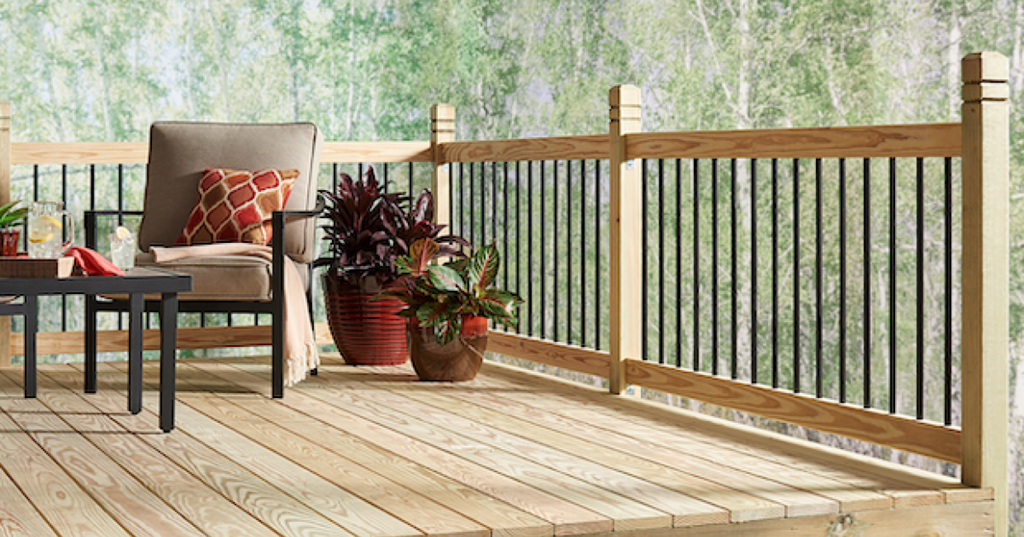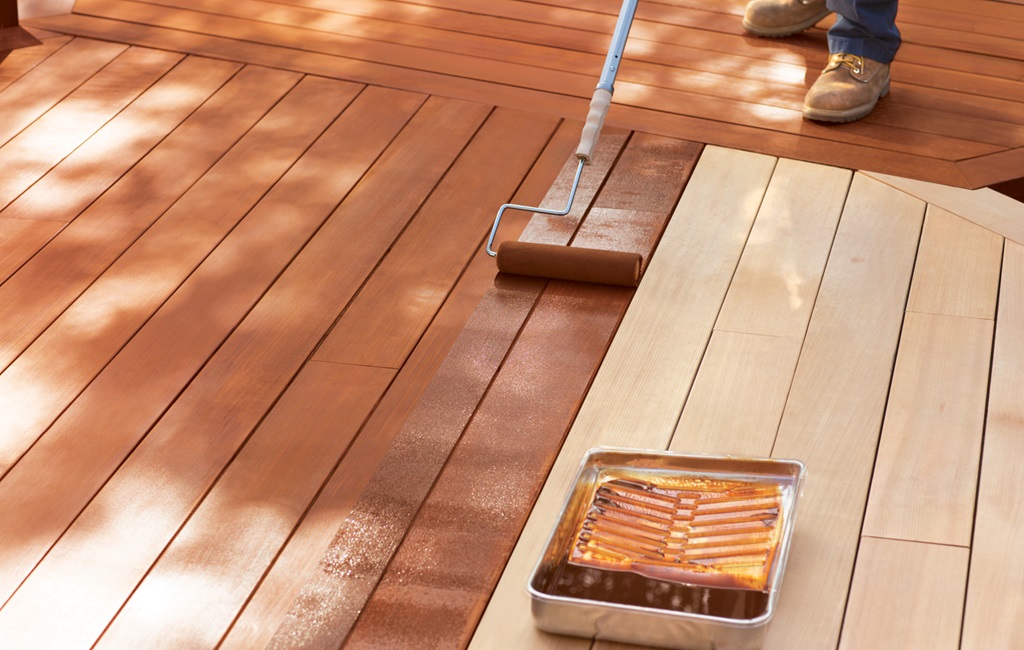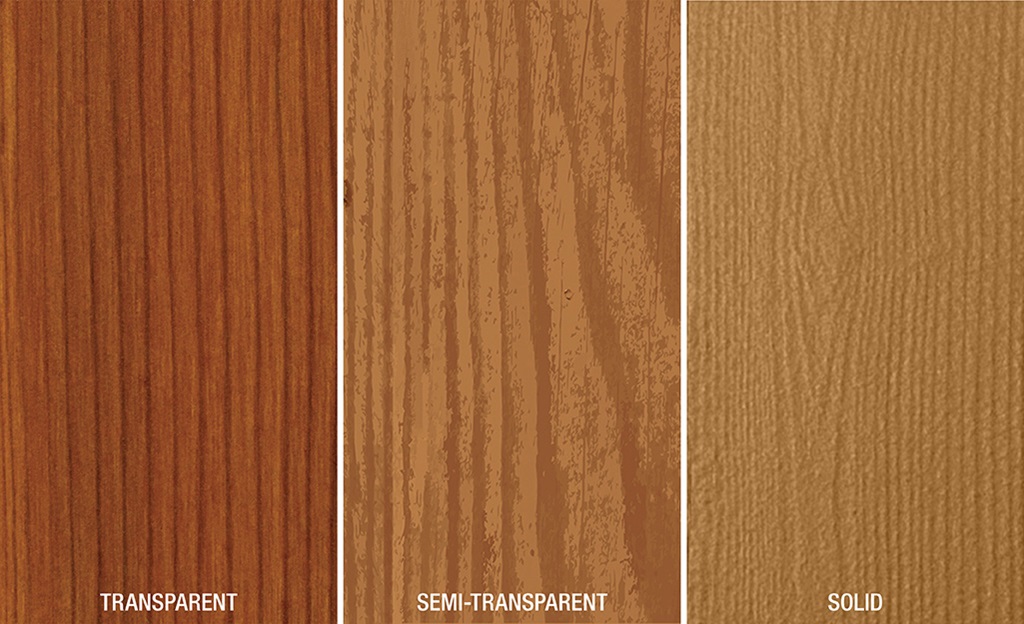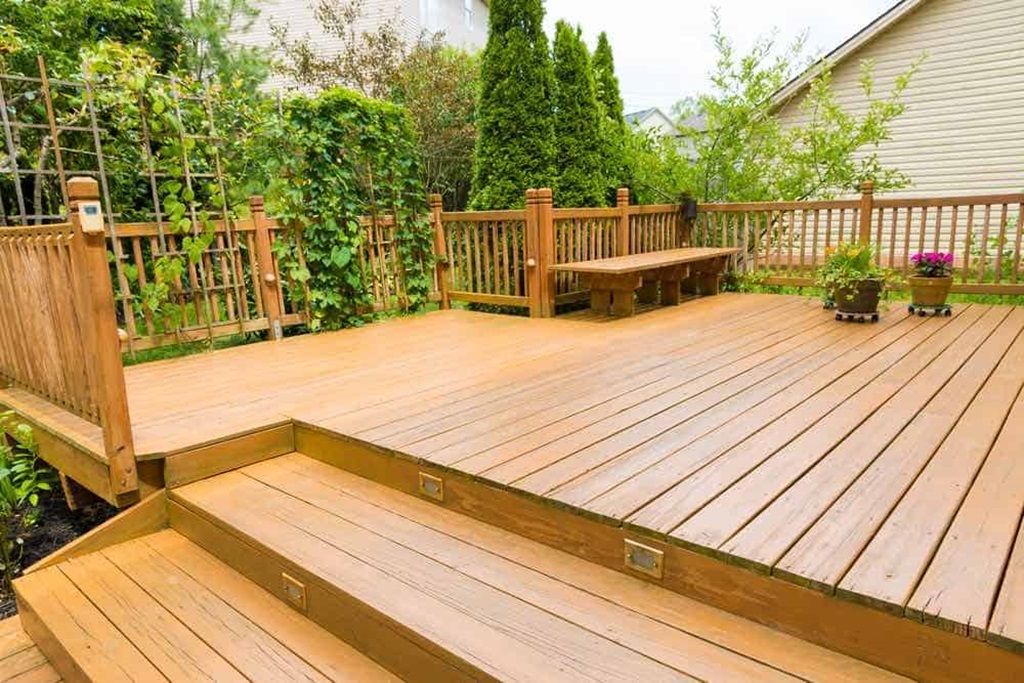Staining a wooden deck is a great way to protect and enhance its natural beauty. There are two types of stains to consider: transparent, which allows the wood grain to show through, and solid, which provides maximum coverage by obscuring the wood texture with an opaque, uniform color.
Choosing the right solid deck stain can be confusing with so many brands and products to pick from. This comprehensive guide will walk you through everything you need to know to find the best solid stain for decks.
What is Solid Deck Stain?
Solid deck stains, also called opaque stains, are thick, pigmented coatings that fully obscure the natural wood grain to achieve a consistent, opaque color. The pigments in the stain give it its coloring, while the resin provides durability against foot traffic, sun exposure, moisture, and other elements.
Unlike transparent or semi-transparent stains that penetrate the wood surface, solid stains coat the exterior of the boards with a film of pigment and resin. This allows the stain to mask imperfections in the wood, providing a renewed, uniform appearance.
Key benefits of solid deck stains include:
- Maximum UV protection to prevent graying and wood damage
- Conceal flaws, cracks, splinters, and grain patterns
- Provide vibrant, consistent color that lasts
- Form a protective film to resist moisture, mildew, and fungus
- Easier to maintain compared to transparent stains
Solid stains are ideal for older, weather-beaten decks needing revitalization as they entirely hide blemishes and renew the appearance. They also allow you to transform the color of your deck dramatically.
Factors to Consider When Choosing a Solid Deck Stain

With a wide range of best solid stain for decks, assessing your specific needs and deck conditions is essential to selecting the right formula. Key factors to consider include:
Deck Wood Type
Solid stains are formulated to work with different wood species. Some are designed specifically for softwoods like pine, while others are made for hardwoods like Ipe. Ensure the stain you choose is compatible with your deck’s wood type.
Color and Finish
One of the most significant advantages of solid stains is the ability to change your deck’s color drastically. Brands offer stains in various hues, from natural wood tones to bright, vibrant colors. The finish can also range from matte to higher sheen.
Durability
Look for a stain rated to withstand several years of sun, rain, snow, and foot traffic on decking. Acrylic, urethane, and enamel resin formulas provide the most durable protection.
Ease of Application
Consider whether you want a water or oil-based stain, which impacts dry times and cleanup. Gel stains can offer smoother application than liquid. Check if primer or prep coats are needed for best results.
Special Properties
Some solid stains also contain mildew inhibitors, UV blockers, and water repellents for extra protection and minimal maintenance. These features are ideal for humid, rainy climates.
Brand Reputation
Established brands known for quality deck products are a safer bet than generic or store brands. Check reviews to compare performance.
5 Best Solid Stain for Decks
Based on critical factors like durability, coverage, application, and color options, here are five top-rated and most recommended solid stains for optimal deck protection.
1. Defy Extreme Solid Color Deck Stain
Defy Extreme is a top acrylic-based stain offering superior durability and a high-quality finish. It forms a thick, protective barrier that withstands harsh weathering for up to 8 years. The thick gel formula resists sagging and uneven coverage for a consistent appearance.
With one coat coverage on most wood types, it goes on quickly with a brush or sprayer. It dries fast to a durable, scuff-resistant finish and is available in 8 rich, semi-transparent wood tones and opaque solid colors. Overall, it is an excellent stain for transforming and protecting your deck.
Key Features:
- Extreme 8-year durability
- Acrylic-based formula
- High-build thickness resists sagging
- Gel consistency for easy brushing
- One coat coverage
- Fast dry time
- Scuff-resistant finish
- Eight semi-transparent and solid color options
2. TWP 100 Series Semi-transparent Deck Stain
The TWP 100 Series is a top choice for a semi-transparent solid stain for outstanding UV protection, mold resistance, and water repellency. It contains trans-oxide pigments that penetrate deep into the wood pores and waterproofer resins to prevent moisture damage.
It applies easily with consistent coverage and has a fast dry time. Providing 2-5 years of protection on decks, it retains a natural wood appearance while obscuring flaws. It’s available in a range of semi-transparent, natural wood tones.
Key Features:
- Deep penetration with trans-oxide pigments
- Powerful UV inhibitors
- Repels water and resists moisture damage
- Contains mildew-inhibitors
- 2-5 years durability
- Semi-transparent, natural wood tone colors
- Easy soap and water cleanup
3. Ready Seal 510 Exterior Stain and Sealer
Ready Seal 510 is a highly protective oil-based formula from unique alkyl paint resins. It penetrates deep into the wood while forming a weather-resistant topcoat that maintains the natural texture and grain of the wood.
Offering 5-7 years of durability, it provides a rich semi-transparent finish in various natural wood tones. It applies easily with a pump sprayer, requiring 24-48 hours to cure fully. Overall, it’s one of the best oil-based solid stains for enhancing the beauty of wood while providing lasting protection.
Key Features:
- Unique oil-based alkyl paint resin formula
- Deep penetration into wood
- Maintains natural wood grain appearance
- Excellent UV protection
- Repels water and resists moisture damage
- Soap and water cleanup
- 5-7 years durability
- Semi-transparent wood tone colors
4. Seaside Opaque Exterior Paint and Primer
Seaside Opaque is one of the best solid deck stain options for maximum hide and vibrant opaque color. The 100% acrylic latex formula provides excellent adhesion and protection while concealing all flaws and wood grain with rich, even color.
Requiring just one thin coat with no primer needed on most woods, it offers effortless application with soap and water cleanup. Fast dry time allows for quick recoating as required. With over 45 modern opaque colors from which to choose, you can give your deck a wholly refreshed, uniform look.
Key Features:
- 100% thick acrylic latex formula
- Opaque solid color hides imperfections
- Excellent adhesion and durability
- Applies easily in one coat
- No primer is needed on most woods
- Soap and water cleanup
- Fast dry time for quick recoating
- 45+ opaque color options
5. Cabot AUSTRALIAN TIMBER OIL Semi-transparent Decking Stain
Cabot Australian Timber Oil provides a durable semi-transparent stain enriched with oil extracts for a natural wood appearance. The unique combination of oils intensely nourishes the wood, while the nano pigments offer adequate UV protection.
Offering easy water-based cleanup, it helps preserve the texture and grain of wood while enhancing its tone with a semi-transparent tint. It repels water to prevent damage from moisture and resists mold, mildew, and fungus. With just one annual maintenance coat needed, it’s one of the most convenient semi-transparent stains.
Key Features:
- Enriched with natural oils to nourish wood
- Nano pigments for UV protection
- Deep penetration into the wood surface
- Repels water and resists moisture damage
- Contains mold, mildew, and fungus inhibitors
- Easy soap and water cleanup
- Semi-transparent colors enhance natural wood
- Requires just one annual maintenance coat
What to Look for When Buying Solid Deck Stain

Once you’ve narrowed down the best type and brand of solid deck stain for your needs, there are some key factors to evaluate before making your final choice:
Check the Labels
Please read the manufacturer’s specifications on the label to ensure it meets your requirements. Verify the stain type, wood compatibility, dry time, coverage rate, durability, and special features like mildew resistance or waterproofing.
Look for Quality Ingredients
For maximum durability and protection, check that the resin is 100% acrylic, urethane, or enamel. See that the pigments are trans-oxide or nano-sized for effective UV resistance and wood penetration. Quality ingredients ensure better performance.
Consider Volume Savings
Buying stain in bulk 5-gallon buckets can offer significant cost savings compared to quarts or gallons. Go more prominent if you need to cover a large deck area.
Compare Prices
Price can vary widely based on quality, brand name, and volume. Weigh the benefits of a more expensive stain against the cost savings of cheaper options to get the best value for your budget.
Check Ratings and Reviews
User feedback can provide helpful insight into the stain’s ease of application, coverage, durability, and color accuracy to set reliable expectations about real-world performance.
Ask About Warranties
Many quality stains have years-long warranties against peeling, cracking, and fading. Warranties give you peace of mind about longevity.
Consider Discount Bundles
Some brands offer money-saving bundles with stains, brushes, gloves, and other supplies included. Kits provide convenience and maximize value.
By carefully checking labels, ingredients quality, volume pricing, user reviews, and warranties, you can feel confident you’ll get the best solid deck stain for your application.
How to Apply Solid Deck Stain for Best Results
Once you have the right solid deck stain product in hand, proper preparation and application techniques are crucial to achieving an even, durable finish:
Clean and Prepare the Deck
Pressure wash the deck with a cleaner to remove dirt, mildew, and old stains. Let the deck dry completely before staining. Sand to smooth any wood roughness for better stain adhesion.
Check for Moisture
Test deck moisture using a moisture meter. Do not apply stain if humidity exceeds 18%, as it can hinder penetration and cure time.
Cover Surrounding Areas
Lay drop cloths to protect siding, plants, grass, and concrete from dripping and splatters. Use painter’s tape for clean lines if needed.
Follow the Manufacturer’s Directions
Read instructions to ensure proper application method, dry time, tools, thinning, and cleanup. Don’t make assumptions.
Stir Stain Thoroughly
Mix the stain to achieve uniform consistency and ensure pigments are fully dispersed before pouring it into the paint tray.
Use Correct Applicator
Choose the tool specified by the manufacturer – usually a synthetic bristle brush, pad applicator, or airless sprayer.
Maintain a Wet Edge
Apply stain in smooth, overlapping strokes while maintaining a wet edge to prevent lap marks as you move across the deck. Work in manageable sections.
Observe Dry Times
Let the stain dry thoroughly between coats, and recoat only within the manufacturer’s specified window to allow proper bonding between layers.
Apply Even Coverage
Maintain consistent brushing motion and pressure to achieve uniform coverage across the entire deck. Avoid blotchiness.
Coat All Sides of the Boards
Don’t forget to stain board ends, undersides, and vertical supports for comprehensive protection.
By prepping thoroughly, following directions, and applying carefully, you’ll get the most out of your high-quality solid deck stain for maximum durability and aesthetic appeal. Maintain it properly for lasting performance.
Solid Stain vs. Semi-Transparent vs. Transparent: Which is Better for Decks?

When deciding how to stain your deck, you must choose between a solid, semi-transparent, or transparent formula.
Which option is best? Here’s a comparison of the pros and cons:
Solid Stain Advantages
- Provides complete opaque coverage
- Conceals flaws, damage, and wood grain
- Transforms color dramatically
- Offers longest-lasting protection
- Easier to maintain over time
Solid Stain Disadvantages
- Film buildup needs sanding/stripping for complete removal
- It doesn’t showcase natural wood beauty
- Limited to darker color choices
- Not breathable – can lead to peeling
Semi-Transparent Stain Advantages
- Allows some wood grain to show through
- It provides protection while enhancing the natural color
- Lower maintenance needs than solid stain
- Greater color variety from transparent to deep tones
Semi-Transparent Stain Disadvantages
- It doesn’t conceal flaws as fully
- Needs reapplication every 2-4 years
- It is more difficult to maintain a uniform appearance over time
Transparent Stain Advantages
- Highlights natural wood grain
- It needs less frequent reapplication than semi-transparent
- Allows the wood to gray naturally
- Keeps the deck looking close to untreated
Transparent Stain Disadvantages
- Minimal durability – reapply annually
- It won’t hide any imperfections
- It provides a minimal color change
- It is hard to maintain a uniform look as wood ages differently
For most homeowners, a high-quality semi-transparent stain provides the best combination of protection, easy maintenance, and showcasing your deck’s natural beauty over time.
Maintaining Your Solid Stained Deck
Once your deck is stained, proper maintenance is crucial for keeping that vibrant, uniform appearance year after year:
- Inspect for solid stains annually and reapply as needed, usually every 2-4 years. Look for fading, flaking, or thinning of coverage. Prep and recoat before the previous coat fails.
- Lightly sand to degloss before reapplying oil-based solid stains. Acrylic stains can be applied over previous coats after cleaning.
- Sweep regularly and spray off dirt, pollen, and debris to limit staining—deep clean annually with a deck cleaning solution.
- Keep coated surfaces free of furniture or planters to prevent uneven fading and allow even water evaporation.
- Evaluate boards and structural elements for cracking, rot, or decay annually. Repair or replace damaged planks as soon as possible.
- Apply a maintenance coat of stain every 1-2 years to high-traffic areas with more wear to keep an even appearance.
With proper prep, application, and maintenance, a high-quality solid deck stain will enhance and protect your deck for years before needing a complete re-do. Follow the manufacturer’s care recommendations for best results.
5 Key Benefits of Staining Your Deck
Beyond just improving appearance, staining provides essential protection for your decking investment.
Here are five key benefits:
- Improved Water Resistance – Quality stains contain water-repelling resins to prevent moisture from absorbing into the wood and causing swelling, cupping, cracking, and rot.
- UV Protection – Stains contain UV-blocking pigments to reflect damaging ultraviolet rays from breaking down the lignin and cellulose in wood over time. This prevents dry rot and graying.
- Resists Mold and Mildew – Many deck stains contain antimicrobial additives that inhibit the growth of stain and odor-causing mold, mildew, and algae on your deck’s surface.
- Easier Maintenance – Stained decks stay cleaner and don’t splinter as quickly as unfinished wood. They allow for easy pressure washing and need re-coating every few years.
- Improved Aesthetics – Stain allows you to refresh and enhance the color of weathered decking for a vibrant, uniform appearance. It covers up blemishes for a clean look.
Investing in quality deck stain provides multiple layers of protection while enhancing your deck’s beauty and functionality for years.
Conclusion

When selecting the best solid stain for decks, thoughtful decisions are essential. This involves evaluating the condition of your current decking, comparing durability, colors, and various brands, and seeking out high-quality ingredients, user feedback, and warranties to guarantee the best possible protection and appearance. By undertaking proper preparation, you can ensure that your deck will look great and last for years.
Frequently Asked Questions
Q: How long does solid deck stain last?
A: On average, a high-quality solid deck stain will last 2-8 years before needing to be reapplied, depending on the brand and formula. Acrylic, urethane, or enamel-based concrete stains provide the most excellent durability, lasting up to 8 years. Opaque stains also tend to last longer than semi-transparent versions.
Q: Do all old stains need to be removed before restaining?
A: For best results, existing deck stains should be removed with thorough cleaning and sanding before applying a fresh coat. However, with acrylic solid stains, you can often recoat without removing previous layers as long as the prior stain is intact without peeling or flaking.
Q: How long does solid deck stain need to dry?
A: Exact dry times depend on weather conditions and specific product formulas, but most solid deck stains are dry to the touch within 1-3 hours. Fully cured dry times range from 24-48 hours for light foot traffic and 1-2 weeks for replacing furniture. Oil-based stains take the longest to heal.
Q: Should deck stain be applied in direct sunlight?
A: Direct sunlight is not ideal when staining your deck. Ultraviolet rays can hinder proper curing and drying. The stain should be applied in the shade or on an overcast day. If sun is unavoidable, work in smaller sections to prevent lap marks.
Q: What is the maintenance schedule for a stained deck?
A: A solid stained deck should be inspected annually for worn or thinning areas and re-coated every 2-4 years to maintain protection and appearance. A maintenance coat should be applied every 1-2 years for high-traffic sections that show wear sooner. Sweep and clean regularly as well.











